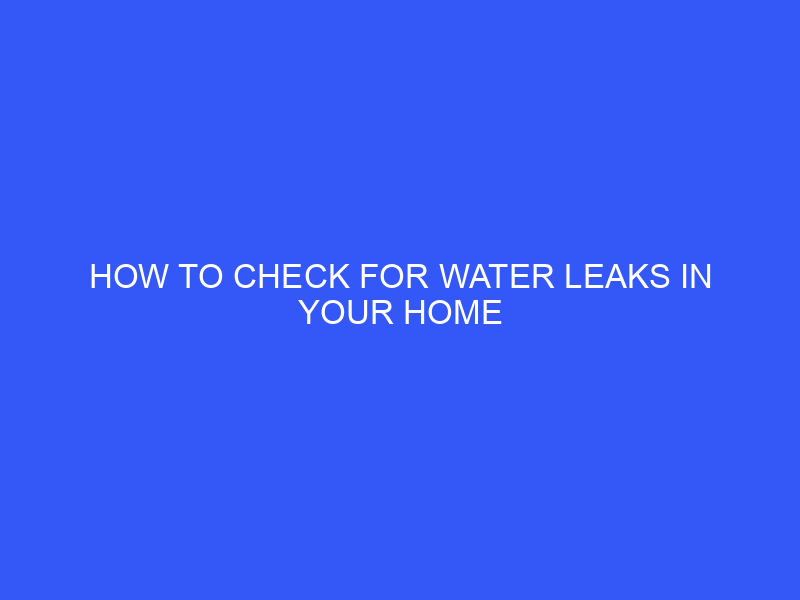Leaks, however inescapable as they seem to be, can be awful. As a property holder, you ought to have the option to distinguish leaks before they become a huge issue. This blog entry will clarify things to consider when checking water leaks in your home. We’ll tell you how to identify a water leak in your yard or home.
Ways to Check if You Have a Water Leak in Your Home
Examining your water bill is one of the simplest ways to determine if you leak. Because leaks produce big jumps in your water bill, an unexpected increase in your expenses could indicate a leak. Of course, you’ll want to deal with a leak before it affects your wallet. So, here are some tangible techniques to check for a water leak in your home:
Check your hot water tank:
Pressure relief valves on hot water tanks are sometimes plumbed straight into drains, making it harder to detect a leak immediately. Look for a spraying or hissing sound, which signals a leak. If you suspect a leak but cannot hear it, remove the drain pipe and physically inspect it for a leak.
Check the toilet tank:
Toilets are a common source of leaks. You should listen to hissing sounds and figure out where they come from. If you can’t see it immediately, try adding food colouring to the tank and seeing if the colour appears in the bowl without flushing. This likely signals a leak in the flapper, which can be repaired without the help of a plumber.
Check the meter line:
Begin by turning off the water and examining the needle at the meter.
If the meter rises after being turned off, there is a leak between the meter and the house. Look around the meter and shut off the valve to find the leak. Even if you can’t find it, this information will help the plumber find it faster and may save you money.
Check for Patches of Greener Grass
Everyone wants a beautiful lawn, but if one part of your yard is significantly greener (and grows quicker) than the rest, it could signal a leaky buried water main. If the leak is substantial, you may observe puddles on the ground’s surface.
Monitor the Water Bill
Monthly water bills are fairly predictable, so you may leak if you receive one that is particularly high despite not using excessive water. Unless you water a nursery or yard in the late spring, a typical family of four will utilise something like 12,000 gallons monthly, per the Ecological Protection Agency. Indeed, even little leaks, like a dribbling faucet, can squander up to 10,000 gallons of water every year, so monitoring your water bill is a reasonable and prudent practice.
Investigate Appliances and Fixtures
If the water meter test indicates a leak in your home, ensure the cabinets beneath the kitchen, laundry, and bathroom sinks are dry. Puddles should be found around the bases of tubs, toilets, and showers, as well as beneath the water heater, dishwasher, and clotheswasher.
If you discover any puddles, shut off the water supply valve to that appliance or fixture and contact a plumber.
FAQ’S
What should you look for first if there is a water leak?
There is no one location to look first, but kitchen sinks, hose bibs, hot water tanks, and toilets are some of the most common places for leaks. You should look for a plumber if you check each spot and don’t detect a leak.
How does one locate the source of a water leak?
Look at your plumbing (shower, lavatory, sinks) to track down the wellspring of a leak. Verify whether there is any hissing. Figure out where the hissing sound is the most intense to assist you with pinpointing the estimated position of the leak.
How can I tell if my pipes are leaking beneath my floor?
When pipes leak beneath the floor, the floor can be damaged. Ideally, you should listen for the sound of water, but if that fails, call a plumber to utilise their listening equipment. If you suspect a leak beneath your floor, contact a plumber immediately.
Is a device available to detect water leaks in walls?
Yes, plumbers frequently use listening discs to determine the location of a leak through walls and furniture.
How does one locate a leak in a yard?
To locate a leak in your yard:
- Turn off the main valve and observe whether the meter continues to run. If it occurs, the leak is between the main and your home.
- Locate a soft or muddy location along the length of the main.
- Contact a plumber immediately to avoid property damage if you cannot determine the location.
What are the two most frequently used methods for detecting water leaks?
Hydrostatic testing and isolation testing are the two most frequent water leak detection techniques. Pressurising the tank or pipe while monitoring water levels in the system is what hydrostatic testing entails. Isolation Testing, however, entails blocking and pressurising a specific section of a plumbing system. When the pressure drops, another test is used to narrow down the leak spot.
Is a leaking pipe an emergency?
Yes. Any leak is a plumbing issue that usually indicates a larger plumbing problem. When you notice a leak, you should call a plumber. If you are still determining where the leak originates, you can use water leak detection services before repairing it.


